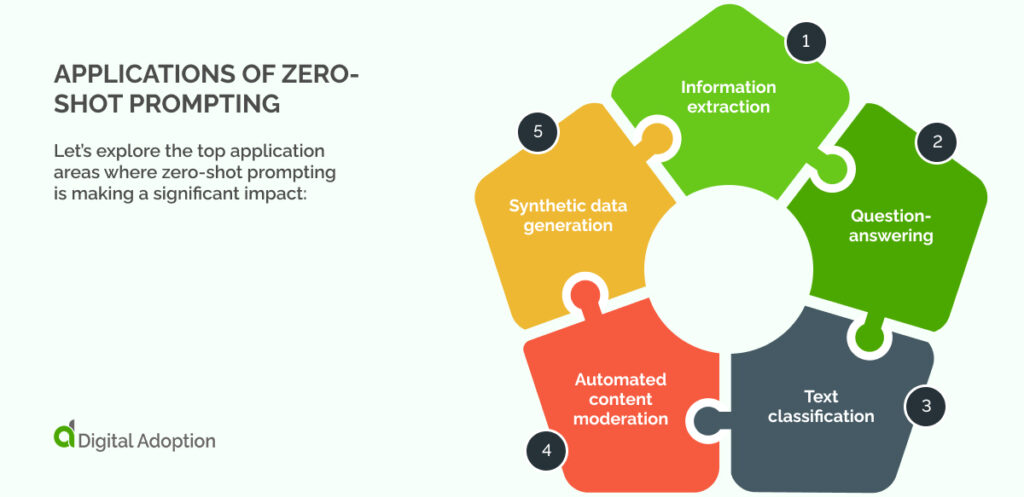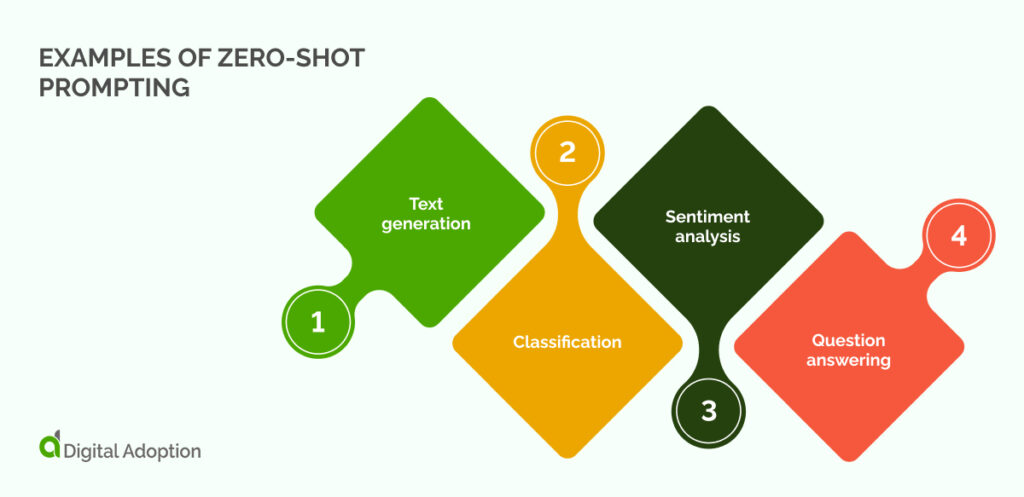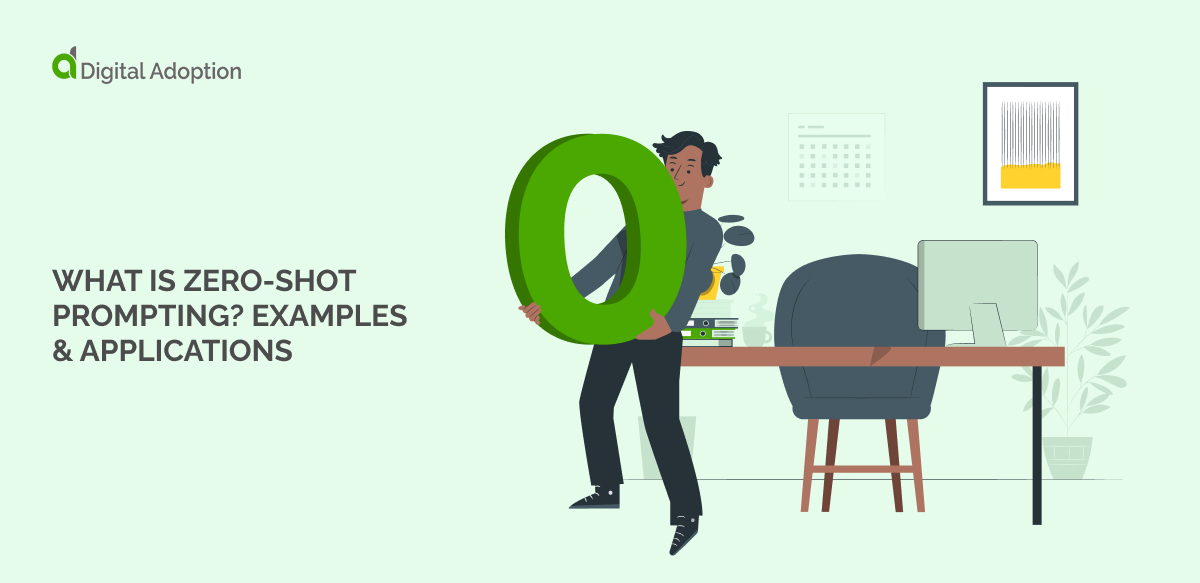Artificial intelligence (AI) is driving a new wave of tech innovation across all sectors.
AI is everywhere, from factory robots to content creation. Tools like Google Gemini and Midjourney AI use machine learning (ML), natural language understanding (NLU), and natural language processing (NLP) to power large language models (LLMs) for generative AI.
LLMs can do more than create images and text. With clear prompts, they can perform tasks without training. This is called zero-shot prompting.
Let’s explore zero-shot prompting, why it matters, and how it will boost AI-driven businesses.
What is zero-shot prompting?
Zero-shot prompting is a machine learning technique where an AI model performs tasks without specific training examples.
It relies on the model’s pre-existing knowledge to understand and execute new instructions or answer questions in contexts it hasn’t explicitly encountered before, demonstrating adaptability and generalization across various domains.
This key method generates relevant outputs using clear, short prompts. Some machine learning models use existing data to guess the most likely answer from an incomplete prompt.
For example, if you ask, “What large, predatory feline is known for its roar and its distinctive mane?” The model will likely predict you’re talking about a lion.
It uses set methods like grouping and reasoning to reach a logical answer. ML models are mostly made to do specific tasks. While they can guess “lion,” they need more training to say more about it.
LLMs, however, can give varied results from text prompts, unlike set ML models. They can grasp the meaning behind inputs. So, if a prompt is written well, they can understand and do new tasks without being programmed for them.
Why is zero-shot prompting important?
Making sure LLM outputs are correct builds trust in advanced AI. Zero-shot prompting fine-tunes instructions to help LLMs work well without extra training.
LLMs’ ability to understand language lets you do different tasks using well-crafted prompts. They are trained on lots of text data, plus built-in skills like logic make them very flexible.
Zero-shot prompting taps into these resources for new uses. This matters because it lets LLMs do specific tasks they weren’t trained for.
Old ML training methods are great for setting goals, but changing an ML model to do new things is difficult for engineers. It needs new data and big changes to the model’s design. LLMs, though, can use their broad knowledge in many areas.
This flexibility will boost efficiency for AI-driven businesses. It saves the time and resources needed to train specific models.
Minimal training means LLMs can learn fast and do many things; zero-shot prompting makes all this possible.
Applications of zero-shot prompting

Zero-shot prompting is changing the way we use AI in various fields. This technique allows AI models to perform tasks they weren’t specifically trained for, greatly expanding their usefulness and flexibility.
Zero-shot prompting is important because it makes AI systems more adaptable and efficient. Instead of needing separate models or extensive training for each new task, a single AI can handle a wide range of applications with minimal setup.
This versatility is crucial today, where new challenges and needs arise constantly. Zero-shot prompting enables quick deployment of AI solutions across different industries and use cases, from customer service to data analysis.
As it improves, new possibilities open up for more intuitive and responsive AI systems. This could lead to significant advancements in how we interact with AI and how AI can assist us in our daily lives and work.
Let’s explore the top application areas where zero-shot prompting is making a significant impact:
Information extraction
Zero-shot prompting helps LLMs pull key data from text without special training.
For example, a model can find dates, names, or places in a document. This is useful in fields like finance or healthcare, where precise information is crucial.
Zero-shot prompting lets these models handle complex tasks, making data processing faster and more accurate.
Question-answering
LLMs can now give accurate answers to questions without extensive training.
For instance, when asked about company rules, an LLM can give precise answers by understanding the question and using its broad knowledge.
This ability to answer many questions on the spot makes zero-shot prompting very useful for customer support, knowledge systems, and education platforms.
Text classification
Zero-shot prompting works well for sorting text into groups.
Usually, models need lots of labeled data to do this. With zero-shot prompting, LLMs can sort text based on the prompt.
For example, an LLM can group customer feedback as positive, neutral, or negative without extra training. This saves time and helps businesses use AI faster.
Automated content moderation
Zero-shot prompting helps improve auto-moderation on digital platforms.
Old systems need lots of training on bad content, which takes time and has limits.
With zero-shot prompting, LLMs can spot and filter harmful content, even if they haven’t seen it before. For instance, a model can find hate speech or fake news in different languages without prior exposure.
This helps platforms stay safer by adapting to new risks and moderating diverse content better.
Synthetic data generation
Zero-shot prompting is changing how we make fake data for testing. Counterfeit data is often used when real data is hard to get or privacy is a concern.
With zero-shot prompting, LLMs can make high-quality fake data that looks real without special training. For example, LLMs can create fake customer feedback or simulated chats to test AI systems.
This speeds up AI development and ensures more diverse data, making models work better in real life.
Examples of zero-shot prompting

Understanding these examples shows how zero-shot prompting can be used for many tasks. It helps get the most out of large language models (LLMs) for various uses without lots of retraining.
Versatility is key to making AI more practical and cost-effective. We can better grasp its potential by seeing how zero-shot prompting works in different situations.
It opens up new ways to use AI in business, research, and everyday life without constant updates or specialized training for each new task.
Let’s look at some examples:
Text generation
Zero-shot prompting lets LLMs create good content from just a prompt.
Example Prompt: “Write a short intro about renewable energy benefits.”
The LLM would write a good paragraph about key benefits like being sustainable and cost-effective. This lets businesses quickly make good content for marketing, reports, and social media without special training.
Classification
Zero-shot prompting is great for sorting text into groups based on a simple prompt.
Example Prompt: “Group these product reviews as ‘Positive,’ ‘Neutral,’ or ‘Negative.'”
The LLM can then read reviews and sort them by feeling, helping businesses handle large amounts of text data, such as customer feedback, more efficiently.
Sentiment analysis
For sentiment analysis, zero-shot prompting lets LLMs figure out the feeling in the text without special training.
Example Prompt: “What’s the feeling in this tweet: ‘I love the new app features, they make life easier!'”
The LLM would say it’s positive. This helps businesses track their reputation, customer happiness, and market trends in real-time from social media and reviews.
Question answering
In question answering, zero-shot prompting lets LLMs give good answers without training on specific info.
Example Prompt: “How does cloud computing help small businesses?”
The LLM would list benefits like saving money and working better together. This is great for customer support, learning tools, and knowledge systems where quick, accurate answers matter.
Zero-shot prompting vs. few-shot prompting vs. one-shot prompting
There are different ways to guide LLMs in doing tasks.
These include zero-shot, few-shot, and one-shot prompting, each with its own benefits.
Zero-shot prompting
This asks the model to do a task with no examples or training. The model must answer based only on what it already knows, which is good when you need quick, flexible responses.
Goal: Get versatile, quick answers without prep examples.
Few-shot prompting gives the model a few examples (usually 2-5) before asking it to do something. This helps the model understand the task better, leading to better results while still being quick.
Goal: Improve task understanding and accuracy with a few examples.
One-shot prompting
This gives the model one example before the task. It mixes zero-shot and few-shot methods, providing guidance with little input and steering the model with just one example.
Goal: Give focused guidance with minimal input for best results.
Diversifying AI with zero-shot prompting
Zero-shot prompting stands to diversify the value of LLMs. Training these systems to deliver targeted results with zero training examples will save time and resources.
Reconfiguring traditional machine learning models to achieve goals beyond their original purpose is easier said than done. Engineers must introduce new datasets and changes to the model’s architecture, algorithms, and parameters.
LLMs, however, can draw on their general understanding and pre-existing pool of knowledge. This flexibility diversifies their offerings for business exploits sector-wide. They can deploy tailored models quickly without the hassle of data preparation, cleaning, and extensive retraining.
Change is the only constant, so agility is key to surviving today’s dog-eat-dog arena. The flexibility and potential for tailored LLM solutions through zero-shot prompting increases operational resilience and speed.
As AI expands its role in various industries, zero-shot prompting will remain essential in unlocking new capabilities, pushing the boundaries of what these models can achieve, and ensuring that organizations stay at the forefront of tech advances.













